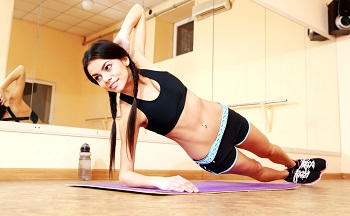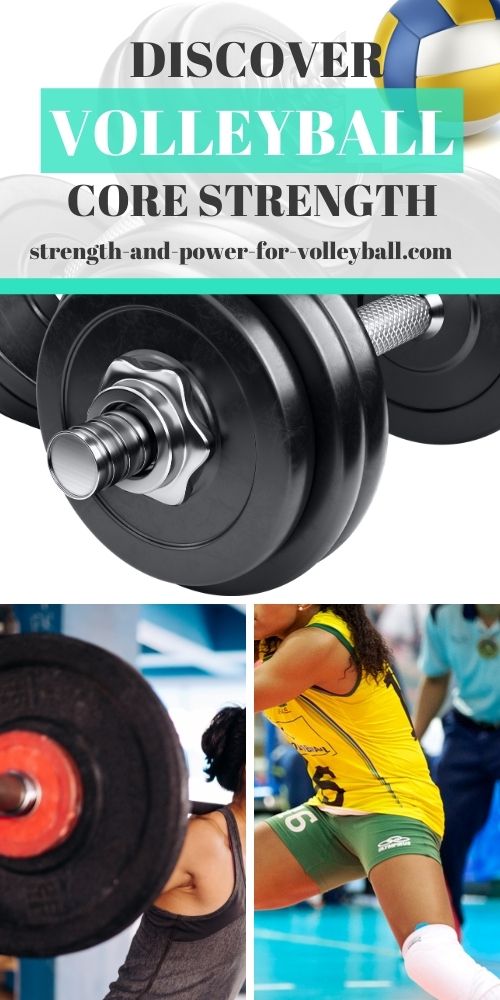Volleyball Core Training
Breathing and Diaphragm Strength
Volleyball core training improves energy, strength, and health. A strong core improves performance and prevents injuries by strengthening the diaphragm and other key muscles.
Think of a strong inner core as, "providing the necessary control when in the presence of change".
Why the Inner Core?
A strong inner core is essential to restoring and improving volleyball performance.
On the following page, you're going to learn...
1. Difference between inner and outer core.
2. Why we want a strong inner core?
3. How do we train the inner core?
Difference between Inner and Outer Core
What modern researchers have been able to do is more clearly define two major stabilizer systems of the body, the inner core and the outer core.
The inner core muscles are..
A) Transversus abdominis and the posterior fibers of obliquus internus
B) Diaphragm
C) Deep multifidus
D) Pelvic floor musculature
Landmine Core Exercise Works the Entire Body
Activation of the inner core provides the necessary stiffness to give
the arms and legs a working foundation from which to operate.
Inner Core Muscles
The outer core muscles include many muscles such as...
A) obliquus externus
B) obliquus internus
C) erector spinae
D) latissimus dorsi
E) gluteus maximus
F) adductors
H) hamstrings
If you enjoyed these tips and would like to keep it close to you at any time, just save this pin to your Pinterest Volleyball Training Board.
So why is a strong inner core important for volleyball?
Volleyball core training the inner core is essentially training the diaphragm.
You can train the diaphragm by increasing intra-abdominal pressure.
Transversus Abdominis (TVA)
As the TVA is activated, drawing the abdominal wall inward, the viscera
(organs
within the chest) are pushed upward into the diaphragm and downward into
the pelvic floor, creating intra-abdominal pressure (IAP).
Intra-abdominal pressure is basically increasing pressure within the abdominal cavity.
Intra-abdominal pressure is the key to a strong inner core.
Diaphragm billows like a parachute
During volleyball core training the diaphragm billows like a parachute by contracting and expanding the chest cavity.
The parachute is one big giant breath.
When air comes up under the diaphragm, the first thing to pick up is the top of the parachute.
While the inner unit muscles are responsible for developing and
maintaining segmental stiffness, the bigger muscles, shown here as
control and suspension lines, are responsible for creating movement.
Think of the control and suspension lines as the outer core muscles
(rectus abdominus, internal and external oblique, erector spinae, etc).
The inner core needs to be strong because if it isn't, the body needs to
compensate in some way. What usually happens is other muscles would
have to start helping out. This can lead to dysfunction.
When the inner core gets dysfunctional, we get pain and can't move right.
Big Belly Breathing vs Chest Breathing
Chest breathers restrict breath movement in the abdomen, forcing it higher up into the chest, while shoulders move up and down.
Chest breathers tend to have higher incidences of neck pain, and they get less oxygen to the body on each breath.
Deep breathing is important when playing volleyball because if you breathe incorrectly, you
won't recover as fast from high intensity efforts.
The faster you recover, the easier it is to focus and play hard.
Powerlifter Using His Core Muscles
In the powerlifting world, you may hear a powerlifter say that it's best to, "get fat"
when performing the movements.
This is referring to taking a deep breath before the lift (filling up the
diaphragm with air).
The powerlifter is taught to push out against the weight belt.
This deep breath and push out of the stomach results in a "fat look".
Intra-Abdominal Pressure
The purpose of this breathing technique is to create intra-abdominal pressure.
When we breath correctly, our large and relatively strong diaphragm
muscle contracts with inhalation, which results in the diaphragm having a
lower position in the thoracic and abdominal cavities, pushing the
internal organs downward. Having nowhere else to go, our organs get
pressed outward, which causes our abdomen to expand.
Intra-abdominal pressure creates stability.
As you are likely aware, when lifting a heavy object or exerting
yourself forcefully to spike a volleyball, it's natural to hold the
breath.
Holding the breath under load is associated with increased tension in the diaphragm.
Breathing may be a reliable indicator of a strong core
Deep breathing techniques may be the missing link to your volleyball core training.
For example, when performing the barbell squat exercise, there is an increase demand for stabilization. As the progressive demand for stabilization increases, the powerful diaphragm contracts to stabilize the torso. Good breathing will strengthen the powerful diaphragm, which protects the spine.
Breathing also has other advantages such as...
- Right muscles firing at the right time. The diaphragm and other inner core muscles should fire before the outer core and other muscles. This will help you workout feeling stronger and more stable. You'll be working out more efficiently which will lead to increasing speed and explosive power.
- Increased endurance. Athletes with a strong inner core will have stronger endurance. This means you aren't as easily fatigued during volleyball tournaments and grueling practices.
- Injury prevention. By developing a stronger inner core, you'll be training your muscles to work in the right sequence while you train. This is important for many reasons. For one, certain muscles act more like mobilizers while other muscles act more like stabilizers. If your inner core is weak, your muscles will get confused about what their primary job is. For example, if the rectus abdominus (a stabilizer) is weak, the hamstrings (a mobilizer) could end up helping out. A likely result is a feeling of tight hamstrings leading to decrease in performance and possible injury.
Volleyball › Smarter Training › Volleyball Core Training

